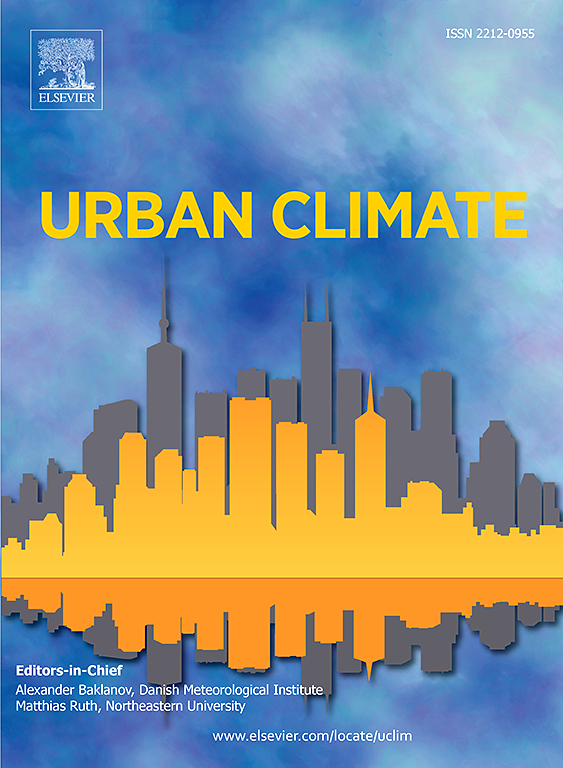湿热气候下树木对邻近公园及社区热舒适影响的CFD研究
IF 6
2区 工程技术
Q1 ENVIRONMENTAL SCIENCES
引用次数: 0
摘要
我们利用计算流体动力学(CFD)对新加坡一个公园和一个住宅区之间的相互作用进行了高保真的微气候模拟。我们揭示了树木更广泛的空间影响,其冷却效应延伸至100米的距离,尽管偶尔伴随着意外的变暖区。树木的多面效应包括种植区内直接的局部降温效应(主要由遮阳驱动),以及受气温、相对湿度和风速影响的各种非局部效应。本案例研究的结果表明,树木可以显著降低通用热气候指数(UTCI)的值,将热舒适水平提高10°C。然而,树木也会引起非局部的加热效应,在高峰时期,公园内无阴影地区的UTCI可增加5°C。UTCI的降低主要来自遮阳效应,因为空气温度降低的冷却效应几乎被相对湿度的增加所抵消。树木造成的挡风作用在+0.5°C UTCI左右具有一致的轻微负面影响。我们还研究了树木与升降建筑下开放空间的相互作用。我们表明,对微气候动力学的这种细致入微的理解对于在湿热气候中正确规划缓解策略至关重要,强调了高保真城市研究的重要性和必要性。这些发现强调了植被对城市热舒适的积极和消极影响,并强调需要先进的热暴露指数来准确评估热缓解策略的有效性。本文章由计算机程序翻译,如有差异,请以英文原文为准。
Impact of trees on thermal comfort in adjacent park and neighborhood in hot-humid climate: A CFD study
We study the interactions between a park and a residential neighborhood in Singapore with high-fidelity microclimate simulations using Computational Fluid Dynamics (CFD). We reveal the broader spatial influence of trees, with cooling effects extending over distances of up to 100 m, though occasionally accompanied by unintended warming zones. Multifaceted effects of trees include the immediate, localized cooling effect in the planted zone, primarily driven by shading, and a variety of non-local effects influenced by air temperature, relative humidity, and wind speed. Results for this case study reveal that trees can significantly reduce values of the Universal Thermal Climate Index (UTCI), improving thermal comfort levels by up to 10 °C. However, trees can also cause non-local heating effects, increasing UTCI by up to 5 °C in unshaded areas within the park during peak conditions. UTCI reduction mainly comes from the shading effect, as the cooling effect of air temperature reduction is nearly offset by an increase in relative humidity. Wind sheltering caused by trees has a consistent minor negative impact of around +0.5 °C UTCI. We also study the interplay of trees with the presence of open space under lift-up buildings. We show that such nuanced understanding of microclimatic dynamics is essential to correctly plan mitigation strategies within hot-humid climates, emphasizing the importance and need of high-fidelity urban studies.
These findings underscore the positive and negative impacts of vegetation on urban thermal comfort and highlight the need for advanced heat exposure indices to accurately assess the effectiveness of heat mitigation strategies.
求助全文
通过发布文献求助,成功后即可免费获取论文全文。
去求助
来源期刊

Urban Climate
Social Sciences-Urban Studies
CiteScore
9.70
自引率
9.40%
发文量
286
期刊介绍:
Urban Climate serves the scientific and decision making communities with the publication of research on theory, science and applications relevant to understanding urban climatic conditions and change in relation to their geography and to demographic, socioeconomic, institutional, technological and environmental dynamics and global change. Targeted towards both disciplinary and interdisciplinary audiences, this journal publishes original research papers, comprehensive review articles, book reviews, and short communications on topics including, but not limited to, the following:
Urban meteorology and climate[...]
Urban environmental pollution[...]
Adaptation to global change[...]
Urban economic and social issues[...]
Research Approaches[...]
 求助内容:
求助内容: 应助结果提醒方式:
应助结果提醒方式:


